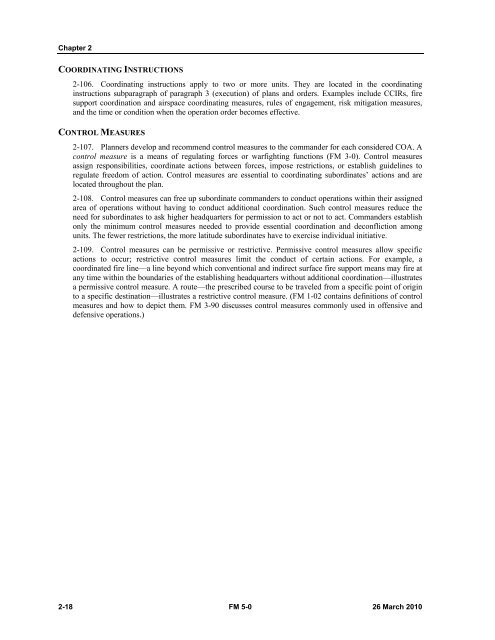FM 5-0, The Operations Process - Federation of American Scientists
FM 5-0, The Operations Process - Federation of American Scientists
FM 5-0, The Operations Process - Federation of American Scientists
Create successful ePaper yourself
Turn your PDF publications into a flip-book with our unique Google optimized e-Paper software.
Chapter 2<br />
COORDINATING INSTRUCTIONS<br />
2-106. Coordinating instructions apply to two or more units. <strong>The</strong>y are located in the coordinating<br />
instructions subparagraph <strong>of</strong> paragraph 3 (execution) <strong>of</strong> plans and orders. Examples include CCIRs, fire<br />
support coordination and airspace coordinating measures, rules <strong>of</strong> engagement, risk mitigation measures,<br />
and the time or condition when the operation order becomes effective.<br />
CONTROL MEASURES<br />
2-107. Planners develop and recommend control measures to the commander for each considered COA. A<br />
control measure is a means <strong>of</strong> regulating forces or warfighting functions (<strong>FM</strong> 3-0). Control measures<br />
assign responsibilities, coordinate actions between forces, impose restrictions, or establish guidelines to<br />
regulate freedom <strong>of</strong> action. Control measures are essential to coordinating subordinates’ actions and are<br />
located throughout the plan.<br />
2-108. Control measures can free up subordinate commanders to conduct operations within their assigned<br />
area <strong>of</strong> operations without having to conduct additional coordination. Such control measures reduce the<br />
need for subordinates to ask higher headquarters for permission to act or not to act. Commanders establish<br />
only the minimum control measures needed to provide essential coordination and deconfliction among<br />
units. <strong>The</strong> fewer restrictions, the more latitude subordinates have to exercise individual initiative.<br />
2-109. Control measures can be permissive or restrictive. Permissive control measures allow specific<br />
actions to occur; restrictive control measures limit the conduct <strong>of</strong> certain actions. For example, a<br />
coordinated fire line—a line beyond which conventional and indirect surface fire support means may fire at<br />
any time within the boundaries <strong>of</strong> the establishing headquarters without additional coordination—illustrates<br />
a permissive control measure. A route—the prescribed course to be traveled from a specific point <strong>of</strong> origin<br />
to a specific destination—illustrates a restrictive control measure. (<strong>FM</strong> 1-02 contains definitions <strong>of</strong> control<br />
measures and how to depict them. <strong>FM</strong> 3-90 discusses control measures commonly used in <strong>of</strong>fensive and<br />
defensive operations.)<br />
2-18 <strong>FM</strong> 5-0 26 March 2010















